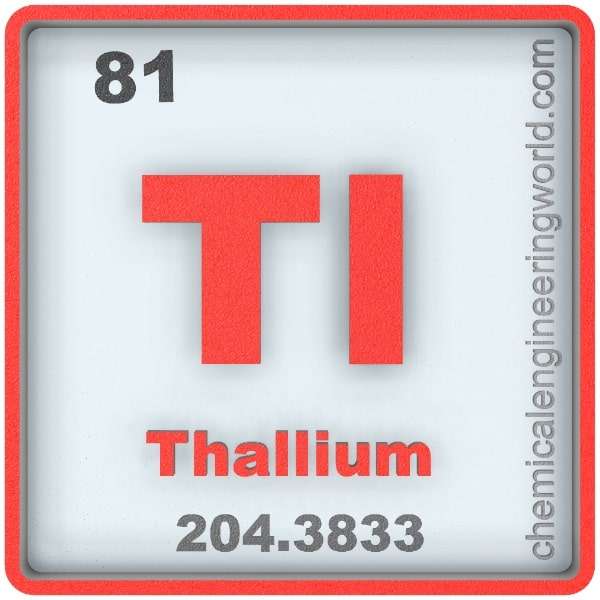Thallium Element Properties and Information

Thallium Element Properties and Information
Thallium is 81st element on the periodic table. Elements are arranged in the periodic table on the basis of the atomic number. Atomic number is the number of protons in the nucleus of the atom. Thallium has an atomic number of 81. It is located in the Group 13 and Period 6 of the periodic table of elements. It is denoted by the symbol ‘Tl’. The name is derived from the Greek word ‘Thallos’ which means ‘Green Twig’.
William Crookes was the first to observe a green colored line in the spectrum of an impure sulfuric acid solution. He announced in 1861 that it is an indication of a new element, however he did not do further research on the metal. Claude-August Lamy was the first to do a thorough research on Thallium in 1862.
The concentration of thallium in Earth’s crust is 0.7 ppm. Thallium is generally found in good quantities in clays, granites, and soils but its extraction from these sources is not economically feasible. Thallium is present in trace amounts in lead, zinc, and copper ores; also, these ores are the sources for industrial extraction of thallium. It is not found in nature in a free-state.
Physical Properties
- Thallium is a gray colored post-transition metal.
- The atomic mass of thallium is 204.38.
- The melting point of thallium is 304°C.
- The boiling point of thallium is 1473°C.
- The density of thallium is 11710 in S.I. units at 20°C.
- Thallium is soft enough to be cut by a knife easily.
- Thallium has 41 isotopes; each of their atomic mass is within the range 176-216. Among them, thallium-203 & thallium-205 are the only stable isotopes.
Chemical Properties
- Thallium tarnishes easily when left in air.
- Thallium(III) compounds find resemblance to aluminium(III) compounds.
- Thallium is the first element in the group 13 elements whose compounds undergo spontaneous decomposition from oxidation state of +3 to oxidation state of +1.
Methods of Production
Purification & Electrolysis: Thallium is found as trace elements in many sulfide-ores of heavy metals; thus, many impurities are separated through variety of impurity separation steps such as froth-flotation, magnetic separation, etc. Also, the thallium is leached using sulfuric acid, and then thallium is precipitated several times from the solution to remove impurities. The thallium is extracted from the thallium sulfate by electrolysis on platinum plates.
Relevance in Chemical & Related Industries
Organic synthesis: Different types of thallium (III) salts are useful for performing transformations in aromatics, olefins, and ketones.
Relevance in Other Industries
- Optics: Thallium (I) iodide and thallium (I) bromide are harder than the usual optics materials, hence they find good use in optics.
- Electronics: Thallium compounds found their use in resistors, detectors, generators, and rectifiers.
Health Effects on Exposure
- Accumulation: Thallium and its associated compounds are quite toxic in nature; accumulation causes tiredness, headache, hair loss, lack of appetite, etc.
- Poisoning: The nervous system and various joints may get affected by thallium resulting in disorder.
Effects on Surroundings
- Plants: Uptake of thallium declines the growth rate of the plants and also changes the color of the leaves.
- Mammals & Rodents: some mammals like Rabbit and some rodents like Rats are highly susceptible to thallium and its compounds, their bodies can absorb it very easily and result in negative consequences.
References:
https://en.wikipedia.org/wiki/Thallium
































